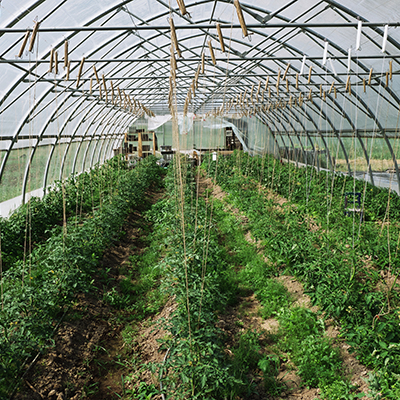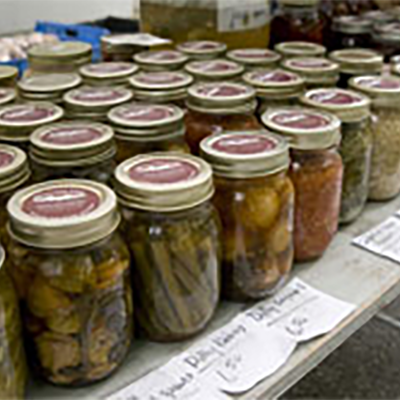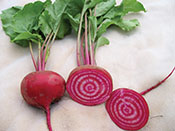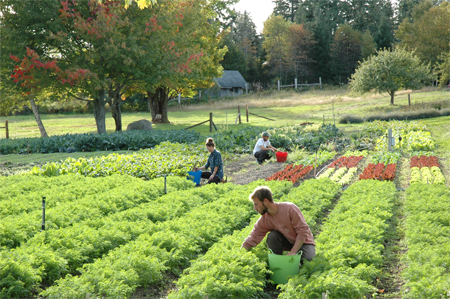Growing for Market in partnership with Johnny's Selected Seeds has created a library of expert information about growing and selling vegetables and flowers. Links in the article will take you to johnnyseeds.com.
Subscribe to Growing for Market for more great ideas about growing and marketing!
For more topics in the series, click on Market Farming Basics in the left column.

Among successful market farms, there is a trend toward diversification and away from specialization. As growers gain  experience,
they tend to add new crops and markets and extend their seasons. They
find ways to maximize income from everything they grow and put all their
land to good use.
experience,
they tend to add new crops and markets and extend their seasons. They
find ways to maximize income from everything they grow and put all their
land to good use.
Many create entirely different but related businesses such as mushroom production or cheese making.
Diversification is nothing new, of course. "Don't put all your eggs in one basket" is one of the oldest proverbs in the English language. It has always been a plain-spoken way of expressing the fact that spreading risk across multiple endeavors provides greater security. The proverb that originated in farming applies more than ever to farming.
And it's especially pertinent on a market farm, where diversification may be the key to survival. If one variety of your most important crop fails, another might succeed. If you lose a crop to a late frost, you could have a succession planting coming along right behind to save the day. If economic problems reduce sales at your main market, you should know where else you could sell the surplus.
Diversification can be applied across every facet of growing. Here's a list of some of the ways growers can diversify. Not all will apply to your business, but they may stimulate some new ways of thinking about your operation.
Diversity in Crop Choice
 A
market farm by definition grows a wide variety of crops to sell
locally. Even so, there may be other crops you have not previously grown
that you could add to your mix.
A
market farm by definition grows a wide variety of crops to sell
locally. Even so, there may be other crops you have not previously grown
that you could add to your mix.
When you look through the Johnny's catalog, think about crops that might fit well with your current production. For example, if you grow salad mix for early spring sales, consider adding a high tunnel of strawberries to sell at the same time?
Could you sell herb plants or vegetable plants? Could you have hanging baskets or flowers or strawberries ready for Mother's Day?
In summer, could you increase your production of non-perishable produce such as shallots and onions? Could you extend your season in fall with storage crops like winter squash, cabbage, and kohlrabi?
Diversity in Variety Selection
Everyone knows the weather is changing and you may find that the varieties you have always grown just aren't as reliable anymore. At Johnny's Research Farm, we see differences in how varieties respond to heat, cold, insect and disease pressure, and other environmental factors. Johnny's and other vegetable breeders are continuously seeking to improve upon older varieties. If you have experienced failures with a variety, we recommend that you trial something new against your old favorites.
Diversity Across Time
 Succession
cropping is an important component of diversification. You can have
several successions of a crop by planting several varieties with
different days to maturity. Or you can plant the same variety several
times, a few weeks apart. If one fails, you haven't lost a lot of time
in trying to replace it. You can also diversify by extending the season
with the use of hoophouses, greenhouses, and low tunnels. Using season
extension structures also reduces risk by providing protection from bad
weather.
Succession
cropping is an important component of diversification. You can have
several successions of a crop by planting several varieties with
different days to maturity. Or you can plant the same variety several
times, a few weeks apart. If one fails, you haven't lost a lot of time
in trying to replace it. You can also diversify by extending the season
with the use of hoophouses, greenhouses, and low tunnels. Using season
extension structures also reduces risk by providing protection from bad
weather.
Geographic Diversity
Your farm may have several microclimates based on topography, or you may have fields with different types of soil. You may be able to get an early crop from a south-facing field, which warms earlier, or keep a cool crop going longer by planting in a field that gets some afternoon shade. You may be able to split production between two separate pieces of land, such as at a farm in the country and a backyard in town. Some growers rent land away from their home farms to take advantage of specific growing conditions such as soil type or wind protection.
In the case of Community Supported Agriculture, growers miles apart from one another often work together to spread risk and provide greater selection to their members. One California CSA, for example, has two farms supplying its products; one farm is in a foggy coastal area and can grow cool-weather crops all summer but not tomatoes and peppers; the other farm is farther inland in a hot, sunny area that is great for heat-loving crops.
Marketing Diversity
Choosing what to grow and when to grow it depends entirely on where you can sell it. If you have been limited by the seasonality of a market such as a summer-only farmers market, you could open up new possibilities for scheduling and crop selection by selling into different markets. Many customers are eager to buy fresh, local food. Among the possibilities: farmers markets, CSA, supermarkets, natural food stores, roadside markets, Pick-Your-Own, home delivery services, restaurants, colleges, corporate dining halls, hospitals, schools, and wholesalers.
Enterprise Diversity
Growing and selling fresh produce is enough work for most people, yet many farmers have ancillary enterprises to help the bottom line and, often, to provide employment year-round for valuable workers. Some examples include: farm stores; on-farm restaurants; on-farm wedding venues; buying and reselling other farm products through CSA or delivery services; freezing, drying, and canning food products; crafting seasonal decorations; bread baking; soap making; mushroom growing; tree farming; and cheese making.
Visit Johnny's Selected Seeds for more free
information about growing produce, herbs, cover crops and flowers.
Subscribe to Growing for
Market for the latest news and ideas.
Reprinted
from JSS Advantage November 2011




 August can be a busy month. Summer crops are at their peak and fall crops need attention. It's time to look ahead to fall and winter markets. Yet, it may still be so hot you just don't want to do anything! We'll suggest some practical ideas and, we hope, provide some encouragement to keep you going.
August can be a busy month. Summer crops are at their peak and fall crops need attention. It's time to look ahead to fall and winter markets. Yet, it may still be so hot you just don't want to do anything! We'll suggest some practical ideas and, we hope, provide some encouragement to keep you going. When you're new to farming, everything is so interesting and exciting that you may assume you'll remember every detail of what you are growing, where and when you planted it, and how well it performed. Veteran growers, however, know that the details start to fade quickly over the course of a busy season. That's why the most experienced and successful farmers keep careful records.
When you're new to farming, everything is so interesting and exciting that you may assume you'll remember every detail of what you are growing, where and when you planted it, and how well it performed. Veteran growers, however, know that the details start to fade quickly over the course of a busy season. That's why the most experienced and successful farmers keep careful records.
 Insect pollination is essential to many vegetable and fruit crops, including tomatoes, squash, pumpkins, watermelons, blueberries, blackberries, apples, almonds, and many others. In the case of watermelons, there will be no fruit without pollination. Some vegetables don't require pollination to set fruit, but pollination by bees will result in larger and more abundant fruits. Nearly 75% of the flowering plants on Earth rely on pollinators to set seed or fruit, as well as one-third of our food crops, and most pollination is performed by honey bees, native bees, and other insects.
Insect pollination is essential to many vegetable and fruit crops, including tomatoes, squash, pumpkins, watermelons, blueberries, blackberries, apples, almonds, and many others. In the case of watermelons, there will be no fruit without pollination. Some vegetables don't require pollination to set fruit, but pollination by bees will result in larger and more abundant fruits. Nearly 75% of the flowering plants on Earth rely on pollinators to set seed or fruit, as well as one-third of our food crops, and most pollination is performed by honey bees, native bees, and other insects. 